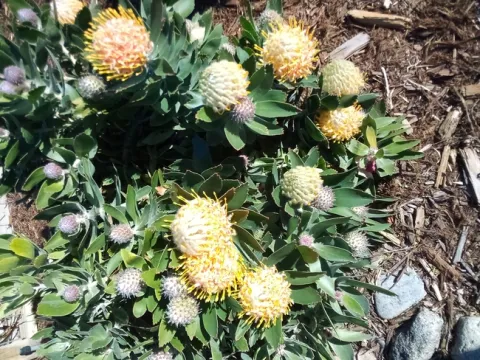
Leucadendron
By Leonard Cicerello UCCE Master Gardener
Leucadendron galpinii
Planting areas: Sunset zones 16,17, 20-24
Size: 6'-8' tall and 4'-6' wide.
Bloom season: Early spring through summer.
Exposure: Full sun.
Pruning needs: Snip a little to maintain compact shape.
Water needs: Moderate water.
Snapshot: The Leucadendron genus is native to South Africa. It is not only related to Protea, but also its flowers are so similar to Protea that they are often mistaken for them.
Leucadendron plants are either male or female. The male plants of the L. galpinii have yellow pompon flowers. The female plants produce soft gray, pink-tinged cones that are as great in arrangements as the male yellow flowers. The foliage on this specie is narrow and the color is gray-green. Its shape is normally upright with dense foliage.
There are about 80 species within the Leucadendron genus. They are stunningly colorful plants. The genus is known for its many bright colors. The flowers of some can grow up to twelve inches in diameter. A bonus is that you get all of that beauty and they are low maintenance. Leucadendrons are commonly called coneflowers or cone bush.
Leucadendrons like well-drained, slightly acidic soil and do not need fertilizer. Maintain adequate distance between plants to avoid disease. They are similar to California native plants in that they are considered drought tolerant. Though they do well in coastal areas, they are a good choice for warm weather. In a warmer climate, water deeply once a week while keeping the foliage from getting wet.
Find comfort in knowing that Leucadendrons are very forgiving. Remove the spent blooms or pinch to encourage dense growth. Keep the plant renewed by pruning woody stems. It is important to leave some new leafy growth with each cut. If you wish to cut it back, wait until all blooming has ceased. When flowering has finished, cut green stems back to four leaves, remembering to leave some leafy growth intact. Then you can rest easy in knowing that it will hibernate successfully through the winter.

